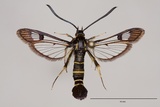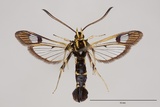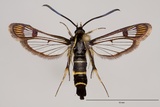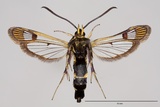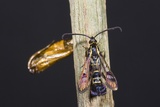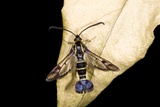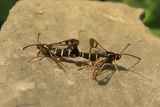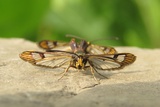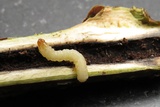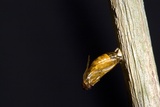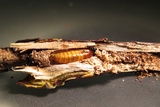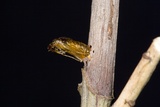Synanthedon tipuliformis (Clerck, 1759) Species
Last modified: Nov. 21, 2025, 7:11 p.m.
This is a fairly common species throughout Belgium.
This species is considered Least Concern according to the IUCN Red List category for Flanders 2023.
Details
- Classification
- Family: Sesiidae > Subfamily: Sesiinae > Tribus: Synanthedonini > Genus: Synanthedon > Species: Synanthedon tipuliformis
- Vernacular names
- Bessenwespvlinder (NL), Currant Clearwing (EN), Sésie du Groseillier (FR), Johannisbeer-Glasflügler (DE)
- First mention in Belgium
- De Sélys-Longchamps E. 1837. Catalogue des Lépidoptères ou Papillons de la Belgique, précédé du tableau des Libellulines de ce pays. — — : 1–29. On page 21 (as Sesia Tipuliformis). view page
- Status
-
Native
Distribution
Imago
S. tipuliformis is a relatively small species (11–20 mm) that can fairly easy be recognised by the orange-ochreous scales between the veins in the apical area of the forewing and the well developed external transparent area being higher than broad and consisting of 5 cells. This species also has well defined yellow bands on the abdomen: 4 bands in the male and 3 bands in the female. The proboscis is, as in all species of this genus, well developed and functional.
The males are very well attracted to the pheromone developed for this species and are best lured in the afternoon but, as always, the optimal time span is very weather dependent.
Egg
The eggs are elliptically shaped and brown.
Mine
The larva constructs a gallery, ranging from only a few centimetres to about 20 cm, in the centre of a twig. The inside of this gallery very often turns black.
Bionomics
The development of this species only takes one year and hence, the larva hibernates only once. The female oviposits on the twigs of the hostplant, preferring two year old ones. The pupation takes place in late spring in a loosely woven cocoon and after the larva prepared an exit hole at the side of the twig leaving only a thin membrane from the outer wall of the sprig. The exclusively day-active imagos are regularly observed sunbathing on the leaves of the hostplant.
The males are very well attracted to the pheromone developed for this species and are best lured in the afternoon but the optimal time span is very weather dependent.
Flight periods
The adults fly from mid-May till mid-July.
Observed on
- Host plant (species):
- Ribes rubrum, Ribes nigrum, Ribes uva-crispa and Euonymus europaeus
- Host plant (genera):
- Ribes
The larva bores into the branches of Ribes, mainly Ribes rubrum and Ribes nigrum but also other species of this genus. So far no larvae have been observed in wild species of Ribes. Rarely –and apparently also locally and not in Belgium– S. tipuliformis caterpillars were found in Euonymus europaeus.
